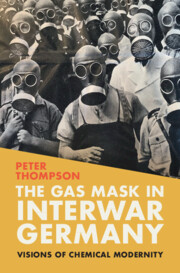Book contents
- The Gas Mask in Interwar Germany
- Science in History
- The Gas Mask in Interwar Germany
- Copyright page
- Dedication
- Contents
- Figures
- Tables
- Acknowledgments
- Abbreviations
- Introduction
- 1 The Structures of Violence: Fritz Haber and the Institutionalization of Gas Warfare
- 2 The Man in the Rubber Mask: World War I and the Development of the Modern Gas Mask
- 3 The First “Chemical Subjects”: Soldier Encounters with the Gas Mask in World War I
- 4 The Limits of Sympathy: The Medical Treatment of Poison Gas during and after World War I
- 5 Atmos(fears): The Poison Gas Debates in the Weimar Republic
- 6 Technologies of Fate: Cultural and Intellectual Prophesies of the Future Gas War
- 7 Synthesizing the “Nazi Chemical Subject”: Gas Masks, Personal Armoring, and Vestiary Discipline in the Third Reich
- 8 Prophets of Poison: Industrialized Murder in the Gas Chambers of the Holocaust
- Conclusion
- Bibliography
- Index
Conclusion
Published online by Cambridge University Press: 11 May 2023
- The Gas Mask in Interwar Germany
- Science in History
- The Gas Mask in Interwar Germany
- Copyright page
- Dedication
- Contents
- Figures
- Tables
- Acknowledgments
- Abbreviations
- Introduction
- 1 The Structures of Violence: Fritz Haber and the Institutionalization of Gas Warfare
- 2 The Man in the Rubber Mask: World War I and the Development of the Modern Gas Mask
- 3 The First “Chemical Subjects”: Soldier Encounters with the Gas Mask in World War I
- 4 The Limits of Sympathy: The Medical Treatment of Poison Gas during and after World War I
- 5 Atmos(fears): The Poison Gas Debates in the Weimar Republic
- 6 Technologies of Fate: Cultural and Intellectual Prophesies of the Future Gas War
- 7 Synthesizing the “Nazi Chemical Subject”: Gas Masks, Personal Armoring, and Vestiary Discipline in the Third Reich
- 8 Prophets of Poison: Industrialized Murder in the Gas Chambers of the Holocaust
- Conclusion
- Bibliography
- Index
Summary
While 1945 clearly demarcates an important curtailment of Germany’s unique ties to chemical weapons, it certainly did not signify the nation’s final confrontation with harmful chemicals or even chemical weapons. The Germans remained within a broader “Chemical Modernity” into which the world had been increasingly plunged since the first industrial production of chemical gases. Indeed, in this longue durée formulation of a Chemical Modernity, it is important to note the extent to which Europeans struggled with environmental concerns such as industrial smoke abatement and arsenic dye poisoning in the nineteenth century.
- Type
- Chapter
- Information
- The Gas Mask in Interwar GermanyVisions of Chemical Modernity, pp. 280 - 287Publisher: Cambridge University PressPrint publication year: 2023

